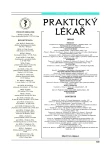Delirium tremens – causal risk factors
Authors:
R. Pilch
Authors‘ workplace:
Psychiatrická léčebna Kroměříž
zastupující ředitel prim. MUDr. M. Koupil
Published in:
Prakt. Lék. 2005; 85(11): 618-621
Category:
Of different specialties
Overview
In the study there are followed up certain risk factors in two categories of patients:
1. Patients in a state of delirium upon withdrawal of alcohol 2. Patients weaning from alcohol without any delirium
Objective:
To determine important risk factors in the appearance and development of delirium tremens, that could then be utilized in clinical practice, namely in checking in of patients and distributing them to different wards, as well as in the planning of further treatment and in diminishing the risk of developing complications of the state of delirium.
Methods:
Out of all patients admitted in 2004 at the department for acute cases and for treating addictions at the Psychiatric Hospital in KromûfiíÏ there have been selected two groups of male patients. The distribution into two groups was determined by fitting under diagnosis F 10.3 or F 10.4 according to the International Classification of Diseases 10. In both groups there have been followed up the following risk factors: 1. epileptic seizure at admission or in personal history, 2. hypertension or elevated blood pressure at admission, 3. head injury, 4. other trauma before admission, 5. hypokaliaemia, 6. increased ALT and/or AST, 7. liver cirrhosis, 8. diabetes mellitus, 9. gastric ulcers or gastropathy, acute and/or in personal history, 10. pancreatopathy, 11. temperatures or infection, 12. manifestations of withdrawal syndrome under simultaneous ebriety at admission. Further, there has also been followed up the frequency of simultaneously present symptoms. There have been searched for connections between the risk factors and the development or presence of delirium tremens. The study comprised a total of 87 patients, of whom 57 suffered delirium, and 30 with simple withdrawal syndrome only.
Results:
In the group of patients suffering delirium there have occurred to a statistically more significant degree hypokaliaemia – RR=3.8 (1.2–12.0), epilepsy – RR=2.75 (1.1–6.9), and the presence of four and more symptoms simultaneously – RR=2.6 (1.1–6.5). A minor finding was a higher mean age in the F 10.4 group – 47±9.0 years as against 43±8.4 in the F 10.3 group at p<0.05. The finding of elevated liver enzyme testes was of borderline statistical significance (p<0.10). Significantly more frequent was the finding of the following signs: injury of the head and extremities, temperatures and pancreatopathy. On the other hand, in the group of patients with simple withdrawal syndrome without delirium there was to a statistically significant degree more frequently present the simultaneous finding of ebriety and abstinence symptoms – RR=6.6 (1.9–23.6).
Conclusions:
The important risk signs identified can relatively easily be detected on admission of the patient by clinical and laboratory investigations, or from his personal history. In thus identified risk groups of checked-in patients there can follow intensive therapy focused on the diminishing of the risk of developing delirium and its complications.
Key words:
delirium – delirium tremens – withdrawal syndrome – alcohol abuse – alcohol addict – risk factors – hypokaliaemia.
Labels
General practitioner for children and adolescents General practitioner for adultsArticle was published in
General Practitioner

2005 Issue 11
Most read in this issue
- Quality of life – defining the concept and its significance for medicine and health care
- Essential hypertension – a review
- Treatment and clinical manifesta- tions of primary intraocular lymphoma
- Risk factors and prevalence of bad posture in school-age children
